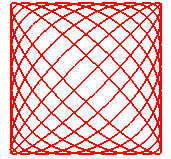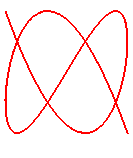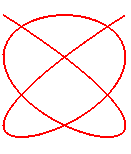LISSAJOUS CURVE or BOWDITCH CURVE

| next curve | previous curve | 2D curves | 3D curves | surfaces | fractals | polyhedra |
LISSAJOUS CURVE or BOWDITCH CURVE


Those who see this movement in the red figure are, supposedly, "right-brain", those who see the oppose movement are "left-brain".... |

Why can't we see this movement in the red figure? |
| Curve studied by Bowditch
in 1815 and by Lissajous
in 1857.
Other names: Lissajous figure. Nathaniel Bowditch (1773-1838): American mathematician and sailor. Jules Lissajous (1822-1880): French physicist. |
| Reduced Cartesian parametrization: |
The Lissajous curves are the trajectories of a point the components of which have a sinusoidal movement.
The Lissajous curves of parameter n (ratio between
the frequencies of the two sinusoidal movements) are the projections on
the planes passing by the axis of the cylindric
sine waves of parameter n:
as well as of the cylindric sine waves of parameter 1/n: .
The curve whose reduced parametrization is in the header
is indeed the projection on xOy of the cylindric sine wave of axis
Oy
and parameter n
and the projection on xOy of the cylindric sine wave of axis Ox
and parameter 1/n
.
If n is irrational, then the curve is dense in
the rectangle .
If n is a rational number whose irreducible form
is , then
it is more convenient to use the following equations:
| Cartesian parametrization: Algebraic curve of degree 2q if Portion of an algebraic curve of degree q if The number of double points is, in general, equal to In the case where the curve can be described in both directions, then there are |
 |
We get a portion of the plot of the n-th Chebyshev
polynomial Tn when n
is an even integer,
and when n is an odd integer,
.
Here are some special cases, with a = b:
When n = 1, we get the ellipses:
 |
 |
 |
When n = 2 (q = 2, p = 1), we get
the besaces:
 |
 |

|
 |

projections of the cylindric sine wave of parameter 2 ( pancake curve) |
 |

projections of the cylindric sine wave of parameter 1/2 ( Viviani's window) |
When n = 3/2 (q = 3, p = 2):
 |
 |
:  Sextic with Cartesian equation |
 Portion of the divergent
parabola with equation: |

cylindric sine wave of parameter 3/2 |

cylindric sine wave of parameter 2/3 |
When n = 4/3, (q = 4, p = 3):
 |
 |
Cartesian parametrization (curve on the right):
Cartesian equation: See here
a tied version of it.
|
n = 5/3
 |
n = 5/4
 |
n = 6/5
 |
n = 8/5
 |
n = 9/8
 |
| The Lissajous curves have the same topology as the curves
of billiard balls in a rectangular billiard table.
See this page. |
 |
| One can also imagine "Lissajous curves in polar coordinates",
with polar parametrization: |
 |
| This beautiful doormat does not follow exactly a Lissajous
curve.
Yet, if in the Lissajous curve |
 |
 |
See also the 3D
Lissajous curves, and the basins.
| next curve | previous curve | 2D curves | 3D curves | surfaces | fractals | polyhedra |
© Robert FERRÉOL 2017